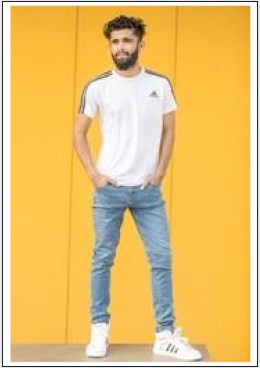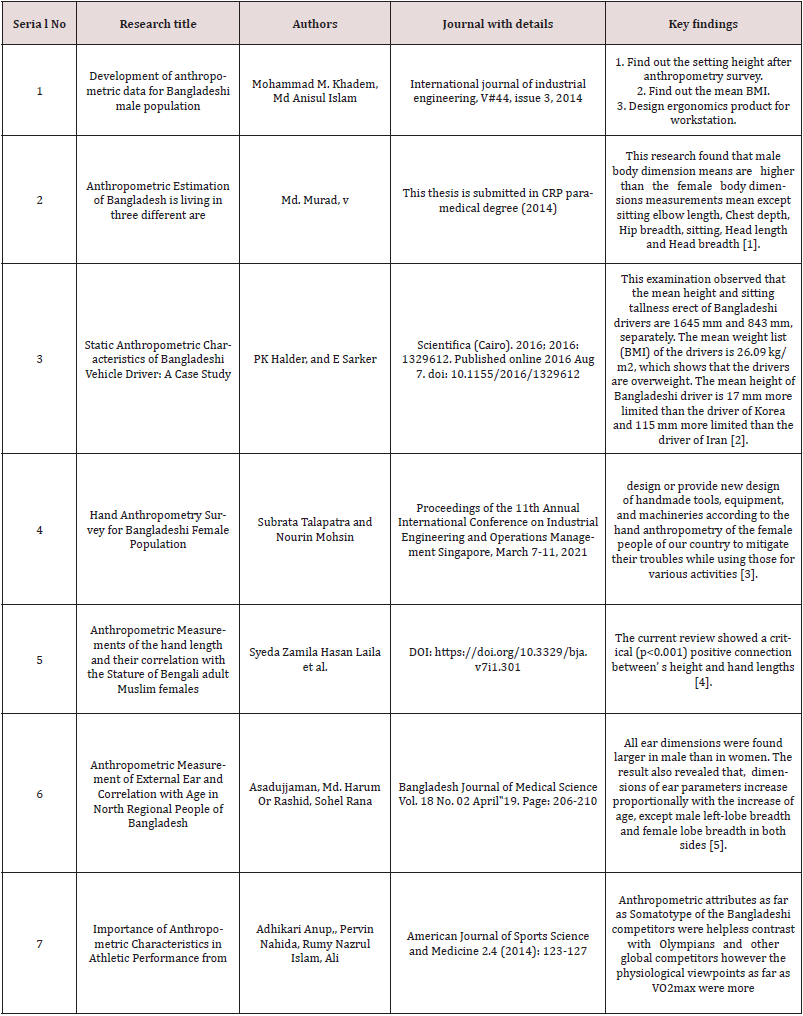
Lupine Publishers Group
Lupine Publishers
Menu
ISSN: 2637-4595
Research Article(ISSN: 2637-4595) 
Anthropometry in Bangladesh Limitation, Possibilities and Future Volume 4 - Issue 3
Eanamul Haque Nizam1* and Darko Ujevic2
- 1Phd, Faculty of Textile and Clothing, University of Zagreb, Croatia
- 2Professor, Faculty of Textile and Clothing, University of Zagreb, Croatia
Received:December 21, 2021 Published: January 10, 2022
*Corresponding author: Eanamul Haque Nizam, Faulty of Textile and Clothing, University of Zagreb, Croatia
DOI: 10.32474/LTTFD.2022.04.000190
Abstract
Anthropometry is very essential survey for any country. Bangladesh has huge amount of garments factories. We have above 0.23 million people. Maximum of the people wear export garments. We haven’t any specific body size chart to determine any body shape. The main aim of this study to find out and summarize the information about anthropometry analysis conducted in Bangladesh. This study will summarize the information about which age, area is included in previous research. After summarizing those data, the author tries to find out the limitation of those research. This study will also propose the possibilities and future of Bangladeshi anthropometry analysis. This study will help for further and improve the next research.
Keywords: Anthropometry; Bangladesh; Size chart; age; survey
Introduction
The word “anthropometry” is gotten from the Greek word
“anthropo” meaning “human” and the Greek word “metron”
meaning “measure” [1]. Anthropometry is the study of estimating
the human body & its parts [2]. The adult persons are the main
productive source of any country. In Bangladesh adults are mostly
working people & they mostly work in the industrial section. But in
Bangladesh there is no appropriate anthropometry data for adult
persons. Anthropometry is the key factor of workplace design.
Anthropometric data is very essential for product design, machine
design & other applications. So, the study was important to conduct
for ergonomics intervention. Anthropometry is very commonly
used as a tool to estimate the nutritional status of populations, and
to monitor the growth and health of individuals. There are three
most frequently anthropometric indices used such as, weight forheight,
height-for-age, and weight-for-age. The weight for height is
an indicator of the present state of nutrition and height for age is
an indicator of past nutrition [3]. The anthropometric assessment
of a population should help in identifying groups at risk of poor
functional outcomes (morbidity and mortality), and who needs
further evaluation or intervention. The anthropometric study
was conducted to compare with other populations to assess the
severity. So, that anthropometry has been an extremely useful
tool for determining the nutritional status of both individuals and
populations. Studies have been in our country the anthropometric
data is very limited [4]. In Bangladesh, we have maximum 0.2 billion
people. Most of the people of this country wear export garments
only. Very few amounts of people wear tailoring garments. We have
not any specific size chart to determine the body shape. In figure 1
shows the body types of Bangladeshi men for clear understanding
(Figure 1). That’s why the Bangladesh cannot create any own
market for their people. Few of the brands like Aroong, Sada Kalo
etc are trying to set their own product in their show room. But most
of the people are not satisfied about their product conform, size
etc. that’s why the author thinks that furthermore research needed
in this very important fields [5]. For conducting and helping the
researcher this study has conducted. Some specific objectives of
this study have summarized in bellow:
a) To sum up, the past research identified this field.
b) To find out the limitation of previous research.
c) To propose the possibilities and future for further study.
Material And Method
The information has collected from different journals, website, and research web site for collecting the information to analyze.
Results
Limitations
In this study, the authors have gathered only few articles research for investigating this part. At first, most of the research has conducted by the mechanical and industrial engineering department. Most of the researcher has explained about the ergonomics, product design, ergonomics, finding out the characteristics etc related to IPE and mechanical engineering. So, here there is no research has conducted related to garments design, fit and comfort. In apparel manufacturing section needs a huge anthropometric analysis to detect the body shape of the Bangladeshi people. Then need to relate to product development, design development, ensure fit and comfort that is the main asking matter in global fashion and textile research.
Possibilities
At present there are about 4800 garment factories in the country and 75% of them are in Dhaka. The rest are in Chittagong and Khulna. These factories have employed 35 lacks people and 85% of them are illiterate rural women. About 77% of our export earning comes from this sector. After agriculture, this is the largest sector of earning of the country people. It has a huge contribution to ease the unemployment problem of the country. Directly and indirectly more than one core people are engaged in this sector. In Bangladesh, there are minimum 0.23 million people. Most of the people of Bangladesh wear export garments and sometimes tailoring garments. We have not any specific human body size chart to specify the garments fit, comfort. There are few brands like Cat’s Eye, Westecs, Artisti, Kay Kraft, Aarong, BanglarMela, Dorjibari, Lubnan, Artnessetccreate design for local market of Bangladesh. In figure 2 shows the different types of brand logo for clear understanding (Figure 2). They order maximum 5000 psc in total. If we segregate this amount against 50 shops. We found only 100 pcs per shop. It’s a huge difference than big brand. There are different reasons behind the scenario. Deferent customer choice will be different. The choice of the customer depends on some factors. They are choice, trend, color, fabric, style, fit and balance. Among those factors fit and balance is the most important factor among those factors. But in most of the case they are not so much happy about the size, comfort of the garments. So, its high time to allocate or through a big national government budget for the human body survey to develop a data sheet. If we can develop this data sheet this will help the national inventor to be a national buyer. We have huge garments factories to produce our own garments.
Future
The total economy of our country will be increased at magic wise. Ultimately, we will be pioneer of a slandered size chart and block pattern for Bangladesh, Sri Lanka, and Pakistan. This study also will ensure the size, pattern block, fit and balance of the ultimate male customer of subcontinent country.
Conclusion and Recommendation
In a multi-cultural society such as Bangladesh, where the populace consists of various ethnic groups with differing body shapes, the findings of the study recommend to different sections to increase the anthropometry research in Bangladesh. The findings suggest that how to increase and how to conduct these experiences. The findings of the study further indicate the need for a representative anthropometric survey of the Bangladeshi population.
References
- Beazley A (1997). Size and fit: procedures in undertaking a survey of body measurements. Fashion Marketing and Management J 2(1): 55-85.
- Devarajan P, Istook CL, Simmons K P (2002) US sizing standards and the US female consumer. Fashion and Text: the New Frontiers – Design, Technology and Business, Hong Kong.
- Elabid, Amel Elkheir Abbas (2009) Development of Human Body Size Measurement for Clothing Using Image Technique. M.Sc Dissertation Faculty of Textile. University of Gezira. Wadmdani. Sudan.
- Simeon B (1973) Berlei size right survey. British Clothing Manufacturer 9(4): 32.
- Detong M, Ashdowns S Butterfield, Tumbladdh KF (1993) Data specification using computers. Cloth Tex Res J 11(3): 1 –7.

Top Editors
-

Mark E Smith
Bio chemistry
University of Texas Medical Branch, USA -

Lawrence A Presley
Department of Criminal Justice
Liberty University, USA -

Thomas W Miller
Department of Psychiatry
University of Kentucky, USA -

Gjumrakch Aliev
Department of Medicine
Gally International Biomedical Research & Consulting LLC, USA -

Christopher Bryant
Department of Urbanisation and Agricultural
Montreal university, USA -

Robert William Frare
Oral & Maxillofacial Pathology
New York University, USA -

Rudolph Modesto Navari
Gastroenterology and Hepatology
University of Alabama, UK -

Andrew Hague
Department of Medicine
Universities of Bradford, UK -

George Gregory Buttigieg
Maltese College of Obstetrics and Gynaecology, Europe -

Chen-Hsiung Yeh
Oncology
Circulogene Theranostics, England -
.png)
Emilio Bucio-Carrillo
Radiation Chemistry
National University of Mexico, USA -
.jpg)
Casey J Grenier
Analytical Chemistry
Wentworth Institute of Technology, USA -
Hany Atalah
Minimally Invasive Surgery
Mercer University school of Medicine, USA -

Abu-Hussein Muhamad
Pediatric Dentistry
University of Athens , Greece

The annual scholar awards from Lupine Publishers honor a selected number Read More...







